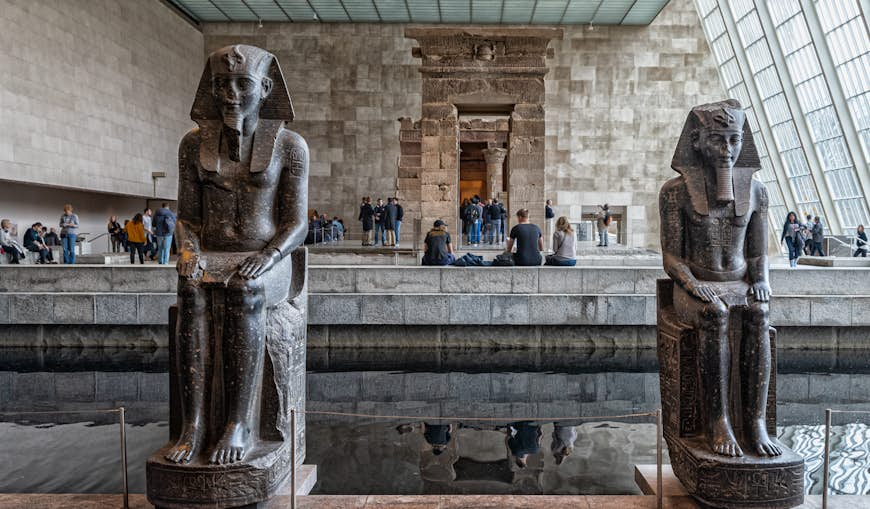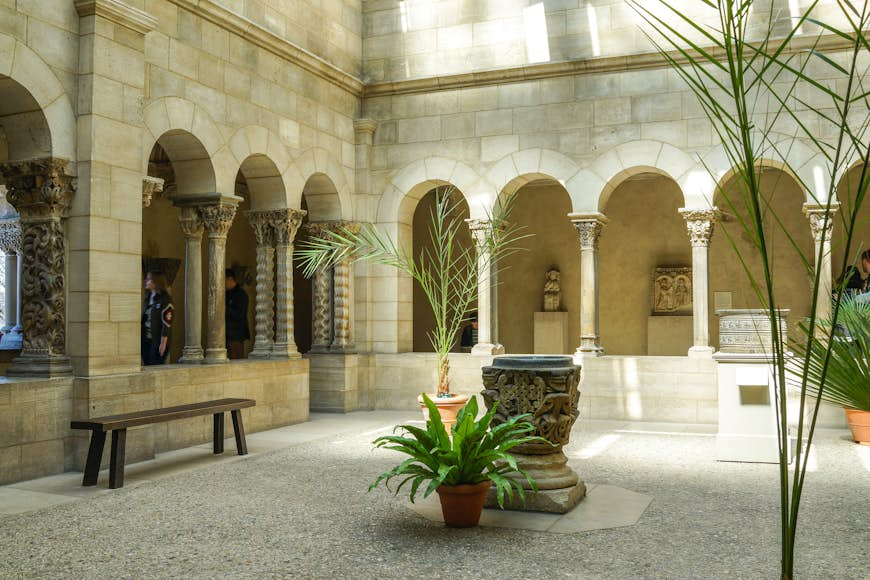
With 5000 years of art in galleries occupying some 2.2 million sq ft, the Metropolitan Museum of Art offers enough to keep an art lover occupied for years. But what if you only have an hour?
A visit to this great New York City institution doesn’t need to be a schlep – provided you do a little research ahead of time. The online museum map is a priceless resource, as are the proposed itineraries below, which you can feel free to add to, cut from, mash up and otherwise customize for yourself.
Whether you have a single hour or a full day, here’s our guide to getting the most out of your visit to the Met.
Immerse yourself in the best experiences the world has to offer with our email newsletter delivered weekly into your inbox.  The Temple of Dendur is a highlight of any visit to the Metropolitan Museum of Art © Creativity lover / Shutterstock
The Temple of Dendur is a highlight of any visit to the Metropolitan Museum of Art © Creativity lover / Shutterstock
How to visit the Metropolitan Museum of Art in 1 hour
Lace up a pair of comfortable shoes, ascend the steps and enter the Great Hall prepared to cover some ground.
Look up at the hall’s soaring beaux-arts domes and admire the lavish floral arrangements (a dedicated flower endowment ensures that they’re refreshed frequently). Then hang a right at the pharaoh sculpture to enter the world of ancient Egypt. You’ll pass haunting funerary portraits and mummies in gallery 138 (look out for a case of mummified dogs, cats and other critters in gallery 135) on your way to the jaw-dropping Temple of Dendur pavilion (gallery 131).
This 2000-year-old structure originally occupied an island in the Nile, before being moved to New York, stone by stone, when the construction of the Aswan Dam threatened to submerge it forever. Note the graffiti scratched by Napoleon’s troops into its sandstone blocks – more evidence that this monument has had admirers on many continents for millennia.
Through glass doors and across (figurative) oceans, you’ll enter the American Wing and its inspiring Charles Engelhard Court (gallery 700). Here, sculptures by Louis Comfort Tiffany, Augustus St Gaudens, Daniel Chester French and other masters testify to the artistic achievements – and huge wealth – of Americans in the Gilded Age.
 The Arms and Armor gallery is popular with children © Joe Ravi / Shutterstock
The Arms and Armor gallery is popular with children © Joe Ravi / Shutterstock
Turn left and into the airy galleries of arms and armor, where metal helmets, cuirasses (breastplates) and gauntlets (gloves) are assembled and dramatically displayed on life-size horse mannequins – a delight for kids. (Keep an eye out for Italian armor made for an aging, extremely portly Henry VIII.) A quick walk through galleries of European sculpture and decorative arts lets you smile at the enchanting Cupid by Michelangelo and pop your head in to examine the trompe l’oeil wood inlay of the Renaissance Studiolo from Umbria, Italy.
Hook back to the Great Hall, then ascend the Grand Staircase (imagining you’ve arrived for the Met gala). A left at the landing takes you past a rotating exhibition of light-sensitive drawings and prints – where you might see anything from a sheet by Leonardo or Rembrandt to antique baseball cards – and, finally, to the glorious maze of galleries containing 19th-century paintings.
Nowhere outside of France is the story of the Impressionist and Post-Impressionist movements told as vividly as in these rooms, where canvases burst with color and figures from belle-époque Paris meet your gaze. These are artworks even those who think they don’t know art will recognize: Monet’s Haystacks, Degas’ dancers, Cézanne’s mountains and Van Gogh’s irresistible Self-Portrait.
As an alternative… Consider spending a full hour carefully examining, comparing and contrasting the pieces in a single gallery. In galleries 540 and 541, exquisite bejeweled pendants from the Jack and Belle Minsky Collection reveal tiny tableaux fashioned from baroque pearls, precious gems and gold filigree. Upstairs, in gallery 240, a room of dramatically lit depictions of Hindu gods let you consider the beauty of Parvati, the fierceness of Shiva, and the astonishments of Indian sculpture.
 Time will fly as you linger in front of the Met’s collection of masterpieces © siso_seasaw / Shutterstock
Time will fly as you linger in front of the Met’s collection of masterpieces © siso_seasaw / Shutterstock
How to visit the Metropolitan Museum of Art in 3 hours
With a bit more time, you can go deeper than the museum’s greatest hits. You’ll have time to linger in front of any work that catches your eye – one of the Met’s greatest pleasures.
Take your time swanning up the huge Grand Staircase and toward the large-format Tiepolo canvases that draw visitors into a trove of European paintings that holds its own against any collection across the Atlantic. As you wander this suite of galleries, you’ll trace the development of European artistic styles from the late middle ages to the 19th century, encountering along the way masterpieces by Brueghel, Velázquez, Caravaggio, Rembrandt, Vermeer… Three hours might go by quickly in these galleries alone.
Yet beautiful objects in three dimensions await in the adjacent department, which houses one of the world’s most extensive collections of musical instruments. As you admire the superb examples of strings, brass, woodwinds and percussion from around the world, hear the sounds they produce by listening to the excellent audio guide.
 The American Wing tells the story of the USA © Anton_Ivanov / Shutterstock
The American Wing tells the story of the USA © Anton_Ivanov / Shutterstock
After you’ve had an earful, proceed into the American Wing. Start on the second floor, where paintings help bring to life the story of the USA from colonial times to the dawn of the 20th century. Highlights include Emanuel Leutze’s enormous George Washington Crossing the Delaware (gallery 760) and John Singer Sargent’s sultry Madame X (in gallery 771). On the ground floor, the Met’s famous period rooms immerse you in the decorative arts of every era of American history. You can imagine Puritans praying before bedtime in the 17th-century Hart Room, grandes dames gossiping in the Gilded Age–era Worsham-Rockefeller Dressing Room and cocktail glasses clinking in a 20th-century living room designed by Frank Lloyd Wright.
After time traveling through US history, teleport across the Pacific to Asia by exploring the hushed, low-lit galleries of Japanese art, where a rotation of treasures might include lacquer screens and to-die-for silk kimonos, scrolls with delicately inked calligraphy and gleaming ceramic pieces. (Isamu Noguchi’s gently burbling Water Stone in gallery 229 is, happily, on permanent view.) Continue through the galleries of Asian art and discover the ingenuity of various Asian cultures, including Korea (gallery 233), Tibet and Nepal (gallery 252), India and South Asia (galleries 234–243) and Southeast Asia (galleries 244–250 – though recent research has thrown the ownership of some Cambodian works into question). Look at dazzling scrolls, bronzes and jade pieces that trace the evolution of the arts of China over thousands of years (galleries 206–213) before ending your visit in the sublime Astor Court, a recreation of a courtly garden from the Ming dynasty – and the ideal place to reflect on the visual feast you’ve just enjoyed.
As an alternative…Combine any one of the permanent-gallery recommendations above with one of the Met’s world-famous special exhibitions. These extensive, scholarly and often exciting shows use the museum’s clout and deep resources to bring together works from collections around the world, their subjects running the gamut from rock-and-roll guitars to Renaissance portraits to Walt Disney–adjacent decorative arts. If you visit between May and September, the annual Costume Institute exhibition (for which that famous gala serves as an opening-night party) combines sartorial scholarship with theatrical flair; famous shows have included surveys of the camp aesthetic, East-meets-West design and the work of the late, great Alexander McQueen. You might find these exhibitions enthralling or puzzling (or both!) – but you’ll never be bored.
 Fit in a visit to the Met Cloisters in Upper Manhattan © Alan Tan Photography / Shutterstock
Fit in a visit to the Met Cloisters in Upper Manhattan © Alan Tan Photography / Shutterstock
How to visit the Metropolitan Museum of Art in 8 hours
A full day within the museum’s walls rewards anyone with an appetite for beauty and a hunger to learn. Start with any (or all!) of the recommendations above, then layer on even more for a complete survey of human creativity few, if any, other museums in the world can match. (Note that our suggestions don’t include the fabulous galleries of African, ancient American and Oceanic art or Ancient Near Eastern art, both of which are totally closed for renovations scheduled to conclude in 2023 and 2025, respectively.)
From the Great Hall, steer to the right of the Grand Staircase to explore the art of the Byzantine world, including carved marble sarcophagi, enamel portraits the size of a postage stamp, mosaics and more. (The crypt-like gallery 302 is especially evocative.) As the Middle Ages roll on in the following galleries, look out for such weird and wonderful objects as an arm reliquary from the 13th century, ivory rosary beads in the form of skulls and astonishingly tiny “prayer nuts,” miniscule devotional scenes carved in wood (apparently with a needle).
As you approach the massive iron choir screen in gallery 305, keep right to enter the newly reimagined survey of British decorative arts (galleries 509–516), which uses top-notch examples of furniture (including full period rooms), silver pieces and delightful teapots from the British Isles from the 16th to 19th centuries to weave a lively cultural history. Next, a short walk takes you across the Channel to 18th-century France in the Wrightsman Galleries (galleries 522–529, 531–533 and 545–547), which contain opulent – you might even say Versailles-worthy – displays of textiles, furniture, porcelain and other luxuries from the ancien régime. Finish your tour of European extravagance by relaxing on a bench in the soaring Petrie Court (gallery 548), where streaming sunlight dramatically dapples larger-than-life-size marble and bronze sculptures.
The Met isn’t totally stuck in the past: its galleries of modern and contemporary art bring the story into the present. A thematic presentation of works by Fernand Léger, Thomas Hart Benton, Balthus, Henri Matisse and other innovators offers a fresh take on the creative revolutions unleashed during the 20th century – while the visual narrative continues upstairs through a slalom-like suite of galleries (918–925) housing large-format abstract works by Mark Rothko, Jackson Pollock, Louise Nevelson and other familiar artists.
Abstractions of a different sort await in the realm of Islamic art – including the ingeniously stylized Arabic inscriptions on a 10th-century Iranian bowl in gallery 450; a 19ft-long Ottoman carpet in gallery 460; and the geometric tilework of the Patti Cadby Birch Court, an immersive, Moroccan-inspired pavilion occupying gallery 456. Yet artists from this region certainly knew how to depict the world in great, superbly naturalistic detail, attested to by the small but sumptuous illustrations from Iran (gallery 462) and Mughal India (gallery 463), whose colors and playful figures are worth examining closely, magnifying glass in hand.
Continue going back in time by descending the stairs to the galleries of Greek and Roman art, awash in natural light and stuffed with ancient masterpieces. You can’t miss the truncated yet still monumental Sardis column in gallery 160, a boundary between the open court of gallery 162 filled with works from the Roman world, and the barrel-vaulted gallery 153, with its procession of Greek sculptures, ritual vessels, armor and other priceless works.
After a packed day of treasure hunting, head up to the Cantor Roof Garden (in the summer months), where outdoor sculpture, views of the Manhattan skyline and cocktails await. You’ll have earned one.
As an alternative… Cut your Fifth Avenue visit to “only” four hours – then take the A train to the upper tip of Manhattan to the enchanting Met Cloisters. Perched on a rocky outcrop overlooking the Hudson River, this unique museum evokes a remote monastery – in fact, the complex is a pastiche of stones, arches and columns that were sourced from medieval European sites before getting transported and reassembled across the Atlantic in the mid-20th century.
Within and between the building’s courtyards (or cloisters), visitors can get close (but not too close!) to masterpieces of European medieval art, including stone burial effigies displayed in a space designed like a Gothic chapel; exquisite stained glass panels; gold chalices, miniature prayer books and even a set of 15th-century playing cards in the intimate Treasury gallery; and – the Cloisters’ star attraction – the magnificent Unicorn Tapestries, which depict animals (mythical and not) and flowers woven from silk, gold and silver threads. The best part: a single ticket is valid for entry to both the Fifth Avenue and Cloisters locations within a three-day window – making this priceless institution a great deal, too.



